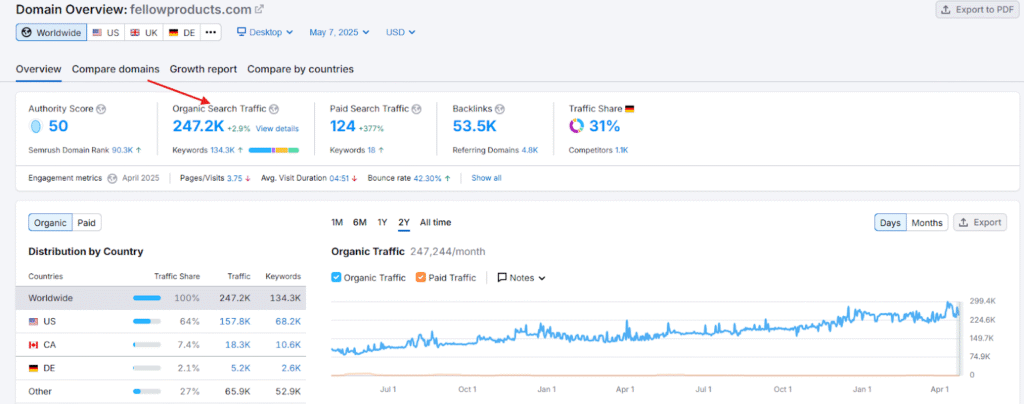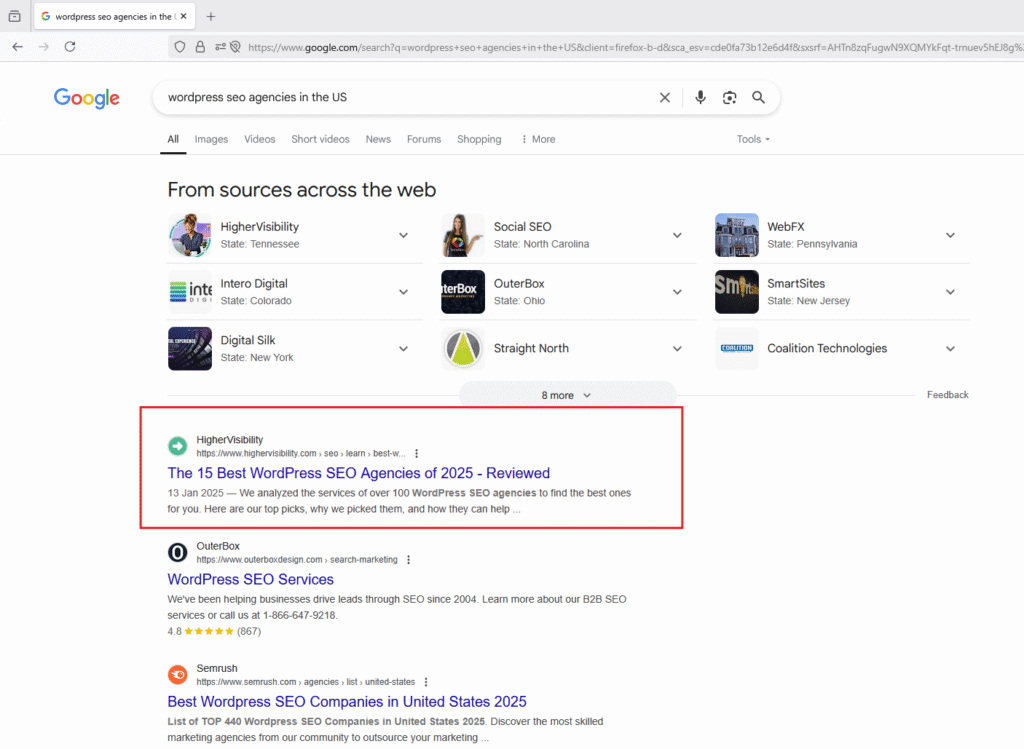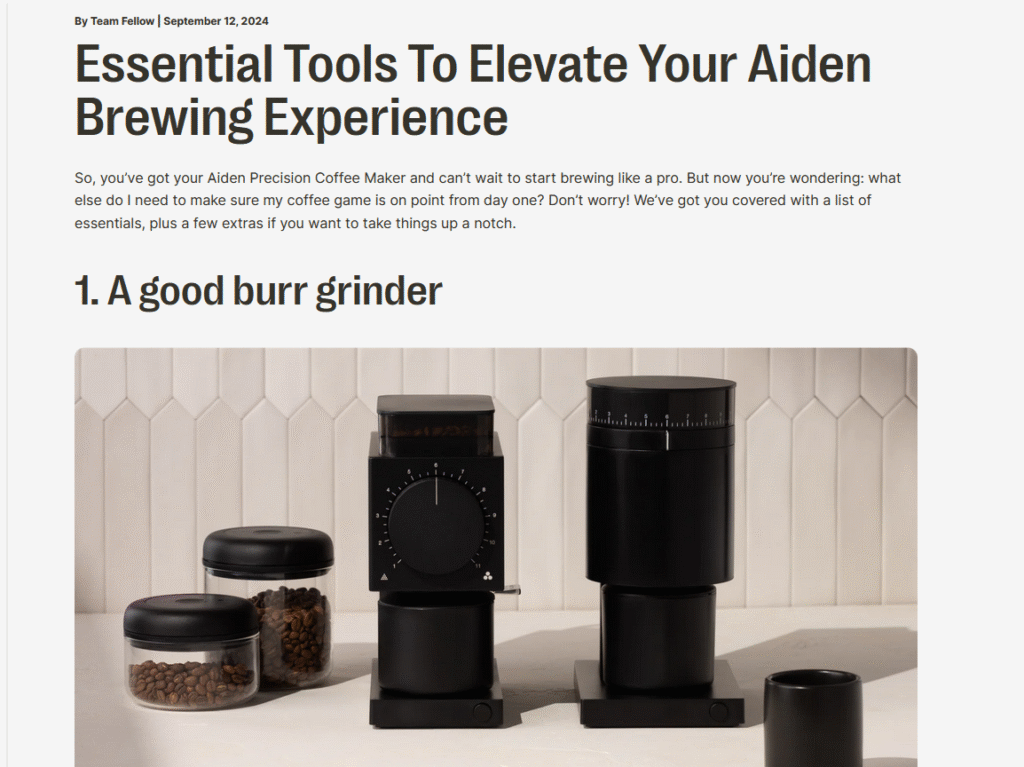Building a Business Case for SEO: How to Convince Your CEO
Key Takeaways
- CEOs care about revenue, margins, and market share, not SEO metrics like keyword rankings or domain authority.
- Frame SEO outcomes in terms of business impact, such as showing how an increase in organic traffic led to specific gains like new trial sign-ups and converted accounts.
- Demonstrating the business value of SEO as a strategic asset can help secure CEO buy-in by aligning it with tangible business outcomes and revenue growth.
You know SEO has long-term value. You’ve seen the data. You may even have blog posts bringing in steady traffic.
But your CEO says no to investing more in SEO.
“SEO is slow.”
“Can’t we just run more ads?”
“We’ll revisit next quarter.”
That’s not because they don’t trust SEO. It’s usually because they can’t see how it helps what they care about: getting more leads, making more money, and increasing market share.
This article will help you demonstrate the value of SEO, position it in business terms, and use real data to build a case that’s easier to say yes to.
7 Ways to Get CEO Buy-In on SEO
1. Speak the CEO’s language: Frame SEO in terms of revenue
CEOs don’t care about the number of keywords you rank for or that your domain authority is 72. They care about revenue, margins, market share, and how to increase them. If you talk about SEO metrics they don’t understand, you’ve already lost them.
As Andreas Obel, a B2B marketing leader, says: “Your CEO speaks business outcomes, not marketing metrics. Your job isn’t to make the CEO a marketing expert. It’s to deliver outcomes they care about.”
So, how can you do this?
Ditch vague metrics like “We increased organic traffic by 38%.”
Replace it with outcomes like “We got a 38% increase in organic traffic. It led to an additional 1,200 qualified sessions per month, which contributed to 22 new trial sign-ups and 5 converted accounts worth $9,500 in new ARR.”
Here, you’re showing the business impact of SEO. Not the marketing/vague metric side of it.
This approach also helps you show SEO as a business asset, not a content experiment. This way, executives who don’t have a mental model for things like “share of voice” or “brand awareness” will still understand why they should invest in SEO from the revenue and reduced CAC point of view.
2. Show, don’t tell: Share mini case studies and before-and-after wins
We worked with Fellow Products, (a coffee maker equipment company), and they’ve been seeing steady results since. This is an overview of their traffic data from SEMrush:

To help them,
- We revamped their product titles and descriptions and made it SEO-friendly to increase brand visibility.
- Used a new content strategy that tackled specific customer pain points.
- We incorporated keywords into every product description and content.
- We also optimized meta tags, secured high-quality backlinks, and improved their technical SEO elements.
All these led to a whopping 31% traffic share for their industry, a 108% increase in organic traffic, and a 28% increase in organic revenue (as of February 2024). We also helped them regain their position at the top of the organic results pages for specific products (which third-party competitors ranked for).
I shared this case study to show how you can get CEO buy-in for SEO by using specific data. And the good news? You likely already have evidence, even if your company hasn’t “done SEO properly.”
How? While developing the website, you (or the developer) must have optimized it with category keywords or pain points specific to your target audience. The separate pages on the website are also possibly optimized to rank online.
So, head to your Google Search Console or GA4 to find pages (or blog posts) that are contributing to your organic traffic. Even one high-performing post (or page) is enough to make your case. Pull data like:
- Organic sessions (before vs. after).
- Leads or demo requests generated.
- Revenue (direct or assisted).
For example, you can say something like “After publishing three blog posts targeting (X problem), we saw a 36% increase in demo sign-ups over six weeks. One piece drove 400 organic visits and converted 12 leads. From this, we closed 2 closed deals worth $7,800 in ARR.”
It all depends on your data.
Even if your product is lower-priced, say, $2,000 in annual revenue, this kind of data-backed story connects SEO to business outcomes. Not just the traffic. It also helps if you can show that this marketing effort reduced CAC, which is always good news.
But you can take it a step further. If you’re to present your argument for SEO in a meeting, create simple slide-ready snapshots or a table in your pitch deck:
| Metric | Before (May) | After (August) |
| Organic Traffic | 2,300 | 7,100 |
| Demo Signups | 12 | 34 |
| CPL | $180 | $58 |
This approach makes it easier to secure budgets for SEO initiatives.
And in the end, what matters in SEO is consistently great results.
The more results from SEO, the more trust the CEO will have in you. And more trust equals more flexibility to invest more in SEO.
And when this happens, you need to be smart about your SEO strategy. That’s what the next point is about:
3. Use comparison content to capture high-intent traffic
When you’re trying to get SEO buy-in, one of the strongest arguments you can make is that not all content is created equal. Some content is far closer to revenue than others.
And comparison content is right at the top of that list.
According to a study, comparison and alternative categories of articles convert at 7.5-8% compared to 1-2% for top-of-funnel blog content.
This means “X software vs Y software” and “best (category) tools” type of content are better than “regular” educational blog posts.

In other words, if you want to capture high-intent traffic and show SEO value fast, go for bottom-of-funnel (BOFU) content. This content answers specific questions from buyers who are comparing solutions before deciding to buy.
So, how do you prioritize BOFU SEO content?
Skip the basic “What is X?” content and focus on what your buyer searches when they’re ready to buy:
For B2B SaaS, this can be:
- “Salesforce vs HubSpot CRM.”
- “Best email marketing tools for startups.”
- Best (industry lead) alternatives for (job-to-be-done).
- “Calendly alternatives for enterprise scheduling.”
- Case studies.
- Reviews and testimonials from happy clients.
These keywords target people who are ready to buy and have money to spend.
Based on the stats above, one good “Calendly alternatives” post can bring in dozens of qualified leads each month, if the content is well-written.
What makes it well-written:
- You show how your product works with screenshots and GIFs of features in action.
- You answer common questions and concerns that might stop someone from buying.
For B2C or franchise/local businesses, BOFU content can be:
- For a dental franchise:
- “Invisalign vs Braces: What’s Better for Adults?”
- “Best teeth whitening options near me (ranked).” Or
- “Best teeth whitening options in (specific location).”
- For a fitness franchise:
- “Competitor vs Your Gym: Which Group Workout Is Best for Fat Loss?”
- “Best gyms in (City) with (specific thing people want).” For example, “Best gyms in (city) with calisthenic coaches.”
These are intent-rich searches where ranking means you’re part of the discussion and decision.
At HigherVisibility, we achieved a similar result with our blog post on “WordPress SEO agency,” which now ranks in the top three search results:

I decided to check Chat GPT to see which agencies it’ll recommend, and we’re the first it mentioned:

This shows that we rank on Google and in a large language model (LLM), which is exactly what CEOs want to see.
By the way, you can also see which of your pages are recommended and referred to by LLMs like ChatGPT through this short guide:
How to find keyword rankings in ChatGPT
How to pitch this approach to your CEO:
Include these in your pitch deck:
- A screenshot showing competitors’ ranking for “Best (your category) Tools.”
- The cost per click (CPC) value from tools like Ahrefs or SEMrush.
- A basic traffic-to-sales estimate, like this:
“This keyword gets 2,000 monthly searches. With a 3% click-through-rate, we’ll get at least 60 clicks from ready-to-buy searchers each month. At a 5% conversion rate, that means 3 qualified sales leads every month.”
Then add: “We can boost these numbers even more by sharing content through our social media accounts and email list.”
This shows the potential return on investment on the keyword and can encourage your CEO to consider organic search.
By the way, if you want a content strategy that’s custom to your company, learn more about our SEO services and request a proposal today.
4. Show the missed opportunity in the SERPs
One of the strongest arguments for SEO is showing your CEO what competitors are doing that you’re missing out on.
People are searching for keywords relevant to your business right now, with or without you. If you don’t show up in those searches, you’re giving business to competitors.
To get SEO buy-in, show your CEO exactly where you’re missing from important searches. These can be:
- “Top (product/service) for (audience)”.
- “(Top competitor) alternatives.” E.g., “5 Calendly alternatives.”
- “(Competitor) vs (Competitor): which is best for (pain point).”
Then, show the results to your CEO:
- Take screenshots of the top 5-10 results.
- Highlight where your competitors appear and what they say about themselves.
- Add comments like: “We don’t show up in the search results at all, but this keyword brings in customers who convert at X%.
To make your point stronger, show how much these keywords would cost in paid ads:
- Competitor A’s blog post about “Best CRMs for Agencies” ranks #1.
- It gets 2,300 visitors each month.
- Each click would cost us $6.80 if we used paid ads.
- That’s $15,640 worth of free traffic every month.
If we bought this traffic with ads, we’d spend almost $16,000 monthly. By not ranking, we’re missing out on free visitors who are ready to buy.
Showing how competitors own the most valuable searches, and how this hurts your brand, can convince your CEO to invest in SEO. You can also show them the cost of investing in SEO versus PPC.
We wrote about the ROI comparison of SEO and PPC.
5. Connect SEO to your company’s current priorities
Linking SEO to your company’s current goals helps you position it as an essential component of your overall marketing strategy.
To do this, start by asking:
- “What are the leadership team’s top priorities this quarter? Making more money? Increasing brand awareness?
- Is the company trying to reduce CAC?
- Is the sales team asking for more qualified leads?
- Is the product team looking to educate the market about a new use case?
- Do we have inventory we need to sell fast?
- Are franchisees under our network asking for more local visibility?
Then show how SEO helps achieve those goals.
For a B2B SaaS company, that may look like this:
- Priority: “Increase qualified leads for Product A.”
- SEO Pitch: “We’ll target keywords like ‘(problem) solution for (target customer)’ and create related content (clusters) that addresses their challenges. This will reduce our need for paid ads over time.”
Another way to say it: “We can help Product A get more leads by ranking for ‘(problem) software for (industry)’. This could save us about $9,400 in ad costs every month.”
The more specific, the better.
For a franchise network or a local business, that may look like:
- Priority: “Increase traffic for underperforming franchise locations. ”
- SEO Pitch: “We’ll create city-level landing pages optimized for ‘best (service) near me’ searches. We’ll then work on increasing local backlinks and reviews.”
If your business is in the consumer product niche, you can also do it this way:
- Priority: “Improve retention by educating new users.”
- SEO Pitch: “Let’s create SEO content that supports onboarding like ‘How to get the most from (product)’. This will also rank for one of the pain points our product solves.”
Here’s an example of that:

While working with Fellow Products, we published an article titled “Essential tools to elevate your Aiden brewing experience”. The goal is to explain how current users of Aiden can buy other products from Fellow Products as accessories to the Aiden Precision Coffee Maker so they can enjoy their brewing experience.
This helps the company speak more about its product. Current users can buy new products, which will help the sales team meet their quota and even reduce reliance on paid ads.
Read more: How paid ads can complement SEO.
6. Design content around real buyer pain points, not just keywords
While traditional SEO starts with keyword research, revenue-focused SEO starts with customer pain points. Doing this helps you avoid the mistake of focusing on keyword volume instead of what your customers actually want to know.
What to do:
Ask your sales team what questions or concerns slow down sales. These are the real customer problems you should address in your content.
If customers often ask about integrations, write: “How to connect (Your Tool) with Slack” or “How to use (your product) for (specific task).”
If prospects ask how your tool compares to competitors, write: “(Competitor) vs (Your Tool): Which works better for (your target customer)?” (Remember to include proof of what makes your product better).
If your product team says a feature is underused, write: “5 ways to save time with (feature y) in (your tool).” Or “How to do (specific action) with (your feature) in (your tool).”
This approach helps you create content that converts and ranks. It also brings your marketing team closer to sales and product teams. When you show your CEO that people are searching for answers you don’t provide, you make a stronger case for how this affects revenue.
7. Build for visibility in AI chatbots, not just traditional search
Ranking on Google isn’t enough anymore. Your brand must also appear in AI answers from ChatGPT, Perplexity AI, Google’s AI Overviews, and Bing Copilot. Without this, you miss a key way buyers find you.
Ryan Law, content marketing director at Ahrefs, predicts that “all informational queries will be answered by AI” soon.

This is because AI tools learn from content published online. If you give up on SEO because it takes time, your company won’t appear when people ask AI about solutions like yours.
However, optimizing for AI is a bit different from traditional SEO. As Lashay Lewis, a growth strategist, explains: “SEO-optimization is no longer enough. Context is king. AI optimization has arrived.”
So, how can you make your brand AI-recommendable?
In her Chat GPT case study, she explains: “GPT dives into your website to understand your product/business, matches it to the (user) query, and pulls from third-party sources to verify and compare information. It doesn’t recommend you unless it can clearly understand what you do and who it’s for.”
Put simply, AI tools look for specific information. They use your website content, trusted review sites, and mentions of your brand across the web when answering questions in your industry.
This means that for B2B software companies to appear in LLMs, you need to be mentioned on trusted sites like G2, Capterra, Gartner, Vendr, and SourceForge. You should also create content focused on:
- Comparison pages (“Calendly vs SavvyCal”).
- Industry pages (“Best CRM for agencies”).
- Pricing, features, benefits, and other relevant pages.
- Pages aligned with persona-specific jobs-to-be-done (for software or consumer products).
For local businesses to appear in LLMs, make sure you’re listed on sites like Google Business Profile, Yelp, Trustpilot, TripAdvisor, Facebook reviews, and industry directories (like Zocdoc for healthcare or Avvo for legal services).
To help AI find and recommend your business:
- Claim and complete all your business listings across platforms.
- Keep your services, prices, hours, and location up to date on all listings.
- Get detailed customer reviews that mention specific features or results.
Read more: Review management strategies for local businesses.
This way, when someone asks, “Where can I get affordable teeth whitening near me with evening appointments?” AI will suggest your dental clinic if your Google Business Profile and website include:
- “teeth whitening” as part of your services.
- “evening appointments” as part of your offerings.
- Location (plus map).
- Positive customer reviews.
If you’re not sure if AI tools are recommending you already, watch this four-minute guide to analyze your traffic sources:
How to find keyword rankings in ChatGPT
Bottom line: AI needs context to recommend your business. If your CEO wants to appear in chatbot responses, where more & more customers are searching, they must invest in SEO and AI optimization.
Conclusion
SEO isn’t just about keywords and traffic. It’s also about business results. With the strategies in this article, you can change how your CEO sees search marketing.
The key is connecting SEO to what matters: money, growth, and being more competitive. Also, remember, when talking about SEO to your CEO, you’re asking for investment in a channel that brings customers to the company. So, focus on keywords that people ready to buy are searching for.
Ready to build your case? Start small by finding one page on your site that’s already bringing in traffic or leads. Calculate its value in terms your CEO cares about, then use that to show what’s possible with more strategic SEO investment.
